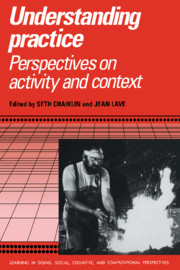Book contents
- Frontmatter
- Contents
- Series foreword
- List of contributors
- Part I Introduction
- Part II Learning craftwork
- 2 Learning to navigate
- 3 Developmental studies of work as a testbench of activity theory: The case of primary care medical practice
- 4 Re-searching psychotherapeutic practice
- 5 Thinking and acting with iron
- 6 Artificial intelligence as craftwork
- 7 Behavior setting analysis of situated learning: The case of newcomers
- Part III Learning as social production
- Part IV Conclusion
- Author index
- Subject index
- Learning in Doing: Social, Cognitive, and Computational Perspectives
2 - Learning to navigate
Published online by Cambridge University Press: 06 January 2010
- Frontmatter
- Contents
- Series foreword
- List of contributors
- Part I Introduction
- Part II Learning craftwork
- 2 Learning to navigate
- 3 Developmental studies of work as a testbench of activity theory: The case of primary care medical practice
- 4 Re-searching psychotherapeutic practice
- 5 Thinking and acting with iron
- 6 Artificial intelligence as craftwork
- 7 Behavior setting analysis of situated learning: The case of newcomers
- Part III Learning as social production
- Part IV Conclusion
- Author index
- Subject index
- Learning in Doing: Social, Cognitive, and Computational Perspectives
Summary
The navigation activity
At all times while a naval vessel is underway, a plot of its past and projected movements is maintained. Day and night, whenever a ship is neither tied to a pier nor at anchor, navigation computations are performed. In a long passage, the navigation activities may be continuously performed for weeks or even months on end. Most of the time the work of navigation is performed by one person working alone, but when a ship leaves or enters port, or operates in any other environment where maneuverability is restricted, the computational requirements of the task may exceed the capabilities of any individual. In such circumstances, the navigation duties are carried out by a team of individuals working together.
The work described here is a continuation of my long-standing interest at looking at cognition in the real world. In earlier work on litigation in the Trobriand Islands (Hutchins, 1978, 1980), and on navigation without instruments in Micronesia (Hutchins, 1983; Hutchins & Hinton, 1984), I was mainly concerned with the influence of culture on the cognition of individual actors where their activities, while socially situated, were considered primarily as individual cognitive accomplishments. Looking at navigation as it is actually conducted aboard ships, however, brought home to me the extent to which cognitive accomplishments can be joint accomplishments, not attributable to any individual. Another absolutely apparent feature of this setting is the extent to which the computational accomplishments of navigation are mediated by a variety of tools and representational technologies.
- Type
- Chapter
- Information
- Understanding PracticePerspectives on Activity and Context, pp. 35 - 63Publisher: Cambridge University PressPrint publication year: 1993
- 117
- Cited by



